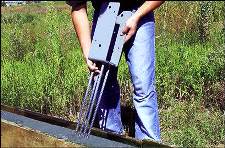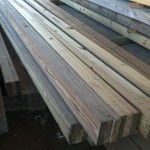Sturdi-Wall Plus Concrete Brackets
Long time readers will recall a previous article regarding Sturdi-Wall Plus concrete brackets:
https://www.hansenpolebuildings.com/2012/09/concrete-brackets-2/
Sturdi-Wall Plus brackets are a heavy-duty engineered anchoring system for attaching wood columns to concrete foundations and are generally used in post-frame buildings but have other applications as well. These brackets are made with ¼ “steel plate A706 rebar in either # 4 or # 5 size, depending on model. Each bracket is precisely welded to meet engineering specifications and given a professional look with a baked polyester powder coat finish. Some brackets are available in a Hot Dipped Galvanized model for use in more corrosive environments.
 Sturdi-Wall Plus brackets are used in a wet set concrete application and provide highest strength bracket to foundation connection when concrete is fully cured. SWP brackets require less concrete coverage than Sturdi-Wall brackets, allowing them to work well in pier foundations, post repair, and renovations. #4 rebar is used in all Sturdi-Wall Plus brackets, except SWP 8 Series where #5 rebar is used. Sturdi-Wall Plus brackets are available in Standard, OT and GL models.
Sturdi-Wall Plus brackets are used in a wet set concrete application and provide highest strength bracket to foundation connection when concrete is fully cured. SWP brackets require less concrete coverage than Sturdi-Wall brackets, allowing them to work well in pier foundations, post repair, and renovations. #4 rebar is used in all Sturdi-Wall Plus brackets, except SWP 8 Series where #5 rebar is used. Sturdi-Wall Plus brackets are available in Standard, OT and GL models.
Standard Models – Accommodate dimensional lumber and laminated columns, typically nailed together with no additional machining.
OT Models – Accommodate some planed laminated wood columns usually mechanically fastened and glued together.
GL Models – Accommodate most planed and glue laminated wood columns (glulams).
In March I attended NFBA’s (National Frame Building Association) 2019 Expo where I met with PermaColumn’s team and recorded this live video for you:
Ready for your new post-frame building, but don’t want to place columns into ground? Sturdi-Column Plus brackets may be just your solution. Call and discuss with your Hansen Pole Buildings’ Designer today at 1 (866) 200-9657.
 Adhesives used in modern glulams are extremely durable and are considered waterproof. Glulam timbers treated after bonding will accept treatment and resist decay similar to treated sawn timbers of the same species and will perform similarly in service. If the appearance of this product is acceptable to the consumer, it can be used successfully in applications where treated wood is required. Provided the structural requirements of the application are met (meaning – was the right size and grade of pole selected for factors such as wind speed, snow load, etc.), treated glulam timbers can be used in place of treated sawn timbers.
Adhesives used in modern glulams are extremely durable and are considered waterproof. Glulam timbers treated after bonding will accept treatment and resist decay similar to treated sawn timbers of the same species and will perform similarly in service. If the appearance of this product is acceptable to the consumer, it can be used successfully in applications where treated wood is required. Provided the structural requirements of the application are met (meaning – was the right size and grade of pole selected for factors such as wind speed, snow load, etc.), treated glulam timbers can be used in place of treated sawn timbers.





